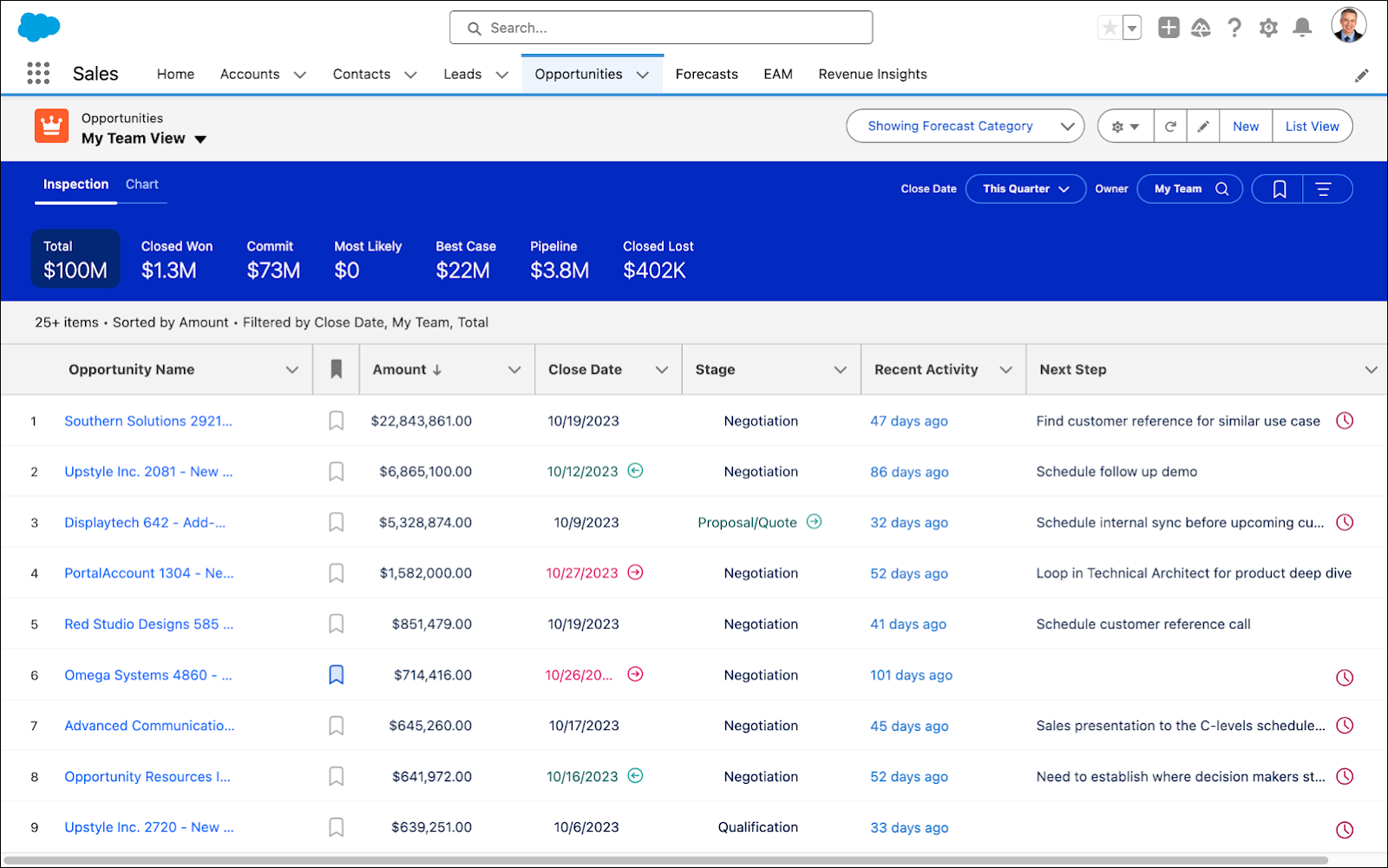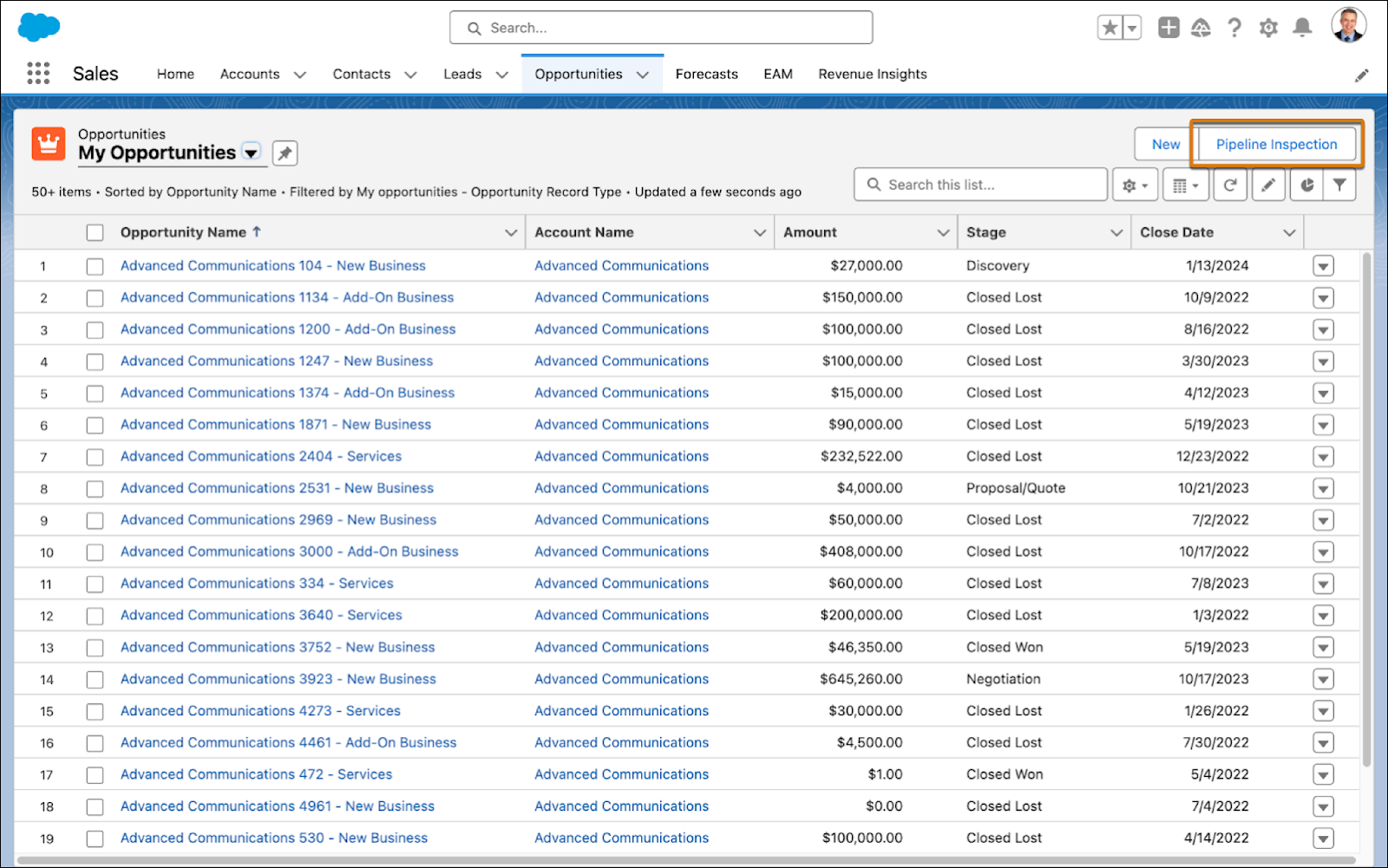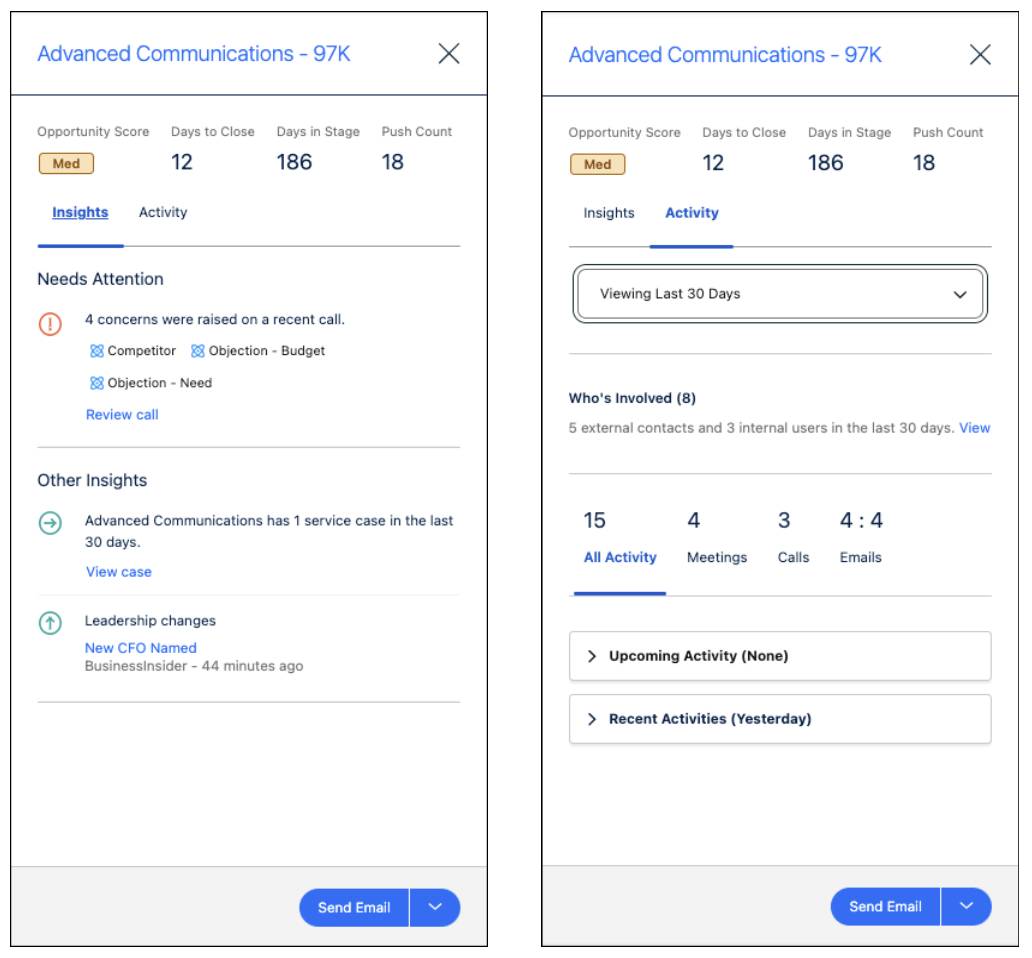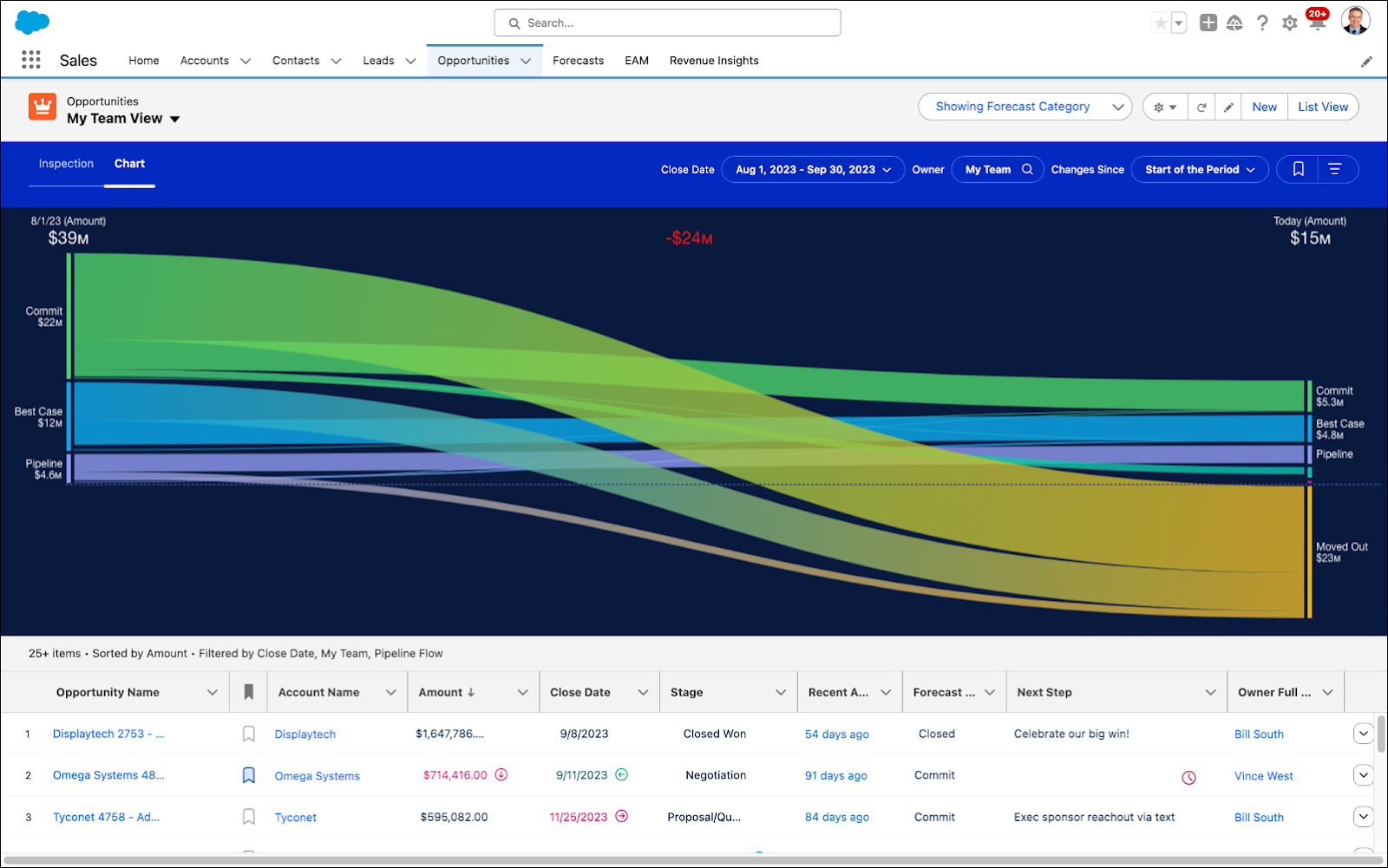Configurar Pipeline Inspection (Inspección de oportunidades en curso)
Objetivos de aprendizaje
Después de completar esta unidad, podrá:
- Saber cómo configurar tendencias históricas para la inspección de oportunidades en curso.
- Saber cómo configurar las mediciones para la inspección de oportunidades en curso.
- Conocer el motivo por el que configurar totalizaciones acumulativas o únicas.
- Describir las funciones de Einstein en Revenue Intelligence y CRM Analytics.
Ahora que ha configurado los conjuntos de permisos pertinentes, puede continuar con su plan de acción mediante la configuración de la inspección de oportunidades en curso.
Primero, proporcione visibilidad a Laura sobre la manera en la que las oportunidades se mueven entre llamadas sobre pronósticos para ayudarla a averiguar qué oportunidades necesitan recursos con Pipeline Inspection (Inspección de oportunidades en curso).
Pipeline Inspection (Inspección de oportunidades en curso) es como la vista de lista Opportunities (Oportunidades) con superpoderes. Es similar a una vista de lista pero mejorada con mediciones de oportunidades en curso, perspectivas y gráficos que no existen en las vistas de lista de oportunidades estándar. Laura espera que los gerentes y representantes de ventas recurran a este recurso para gestionar sus oportunidades en curso.
Si su organización tiene una versión más nueva que Summer ’23, es posible que Pipeline Inspection (Inspección de oportunidades en curso) esté activada. Puede seguir estos pasos para decidir si quiere cambiar cualquier parámetro predeterminado.
Cuando configure Pipeline Inspection (Inspección de oportunidades en curso), debe hacer lo siguiente:
- Active Pipeline Inspection (Inspección de oportunidades en curso).
- Haga que el botón Pipeline Inspection (Inspección de oportunidades en curso) esté visible en la página Opportunities (Oportunidades).
- Configure la tendencia histórica para los elementos de oportunidades.
- Configure las mediciones para Pipeline Inspection (Inspección de oportunidades en curso).
Activar la inspección de oportunidades en curso y la verificación de la tendencia histórica para el elemento Opportunity (Oportunidad)
Pipeline Inspection (Inspección de oportunidades en curso) puede mostrar cómo se han movido las oportunidades, dónde hay cambios de importes y fechas de cierre, y los cambios de etapa y categoría de pronósticos. Esto se hace anotando los campos Amount (Cantidad), Close Date (Fecha de cierre), Forecast Category (Categoría de pronóstico), y Stage (Etapa) con colores e iconos y proporcionando más información al pasar el cursor sobre los campos.

Para ello, Pipeline Inspection (Inspección de oportunidades en curso) utiliza tendencias históricas del objeto Opportunities (Oportunidades). Al configurar la tendencia histórica, los gerentes de ventas de Get Cloudy pueden ver cambios similares en la vista de Revenue Insights.
Puede activar Pipeline Inspection (Inspección de oportunidades en curso) y comprobar que la tendencia histórica está activada para los campos de objeto de oportunidad que necesita Laura.
- En Setup (Configuración) | Pipeline Inspection Setup (Configuración de Inspección de oportunidades en curso), haga clic en Turn on Pipeline Inspection (Activar Inspección de oportunidades en curso).
- Haga clic en View historical trending settings (Ver la configuración de tendencia histórica) y confirme que el objeto Opportunity (Oportunidad) está en la lista Historical Trending (Tendencia histórica). Si quiere ver la tendencia histórica de más campos, como un campo personalizado de importe, lo puede hacer ahí.
Hacer que el botón Pipeline Inspection (Inspección de oportunidades en curso) esté visible en la página Opportunities (Oportunidades)
Laura y su equipo pueden acceder a Pipeline Inspection (Inspección de oportunidades en curso) con un botón que agregue en la página de la vista de lista Opportunity (Oportunidad). Puede agregar el botón desde la página de configuración de Pipeline Inspection (Inspección de oportunidades en curso). La página muestra un paso más después de agregar el botón: Proporcionar a los usuarios acceso a Pipeline Inspection (Inspección de oportunidades en curso). Como ya ha asignado los conjuntos de permisos de Revenue Intelligence a los usuarios, puede saltarse este paso.
- Para agregar el botón, haga lo siguiente: En la página Pipeline Inspection Setup (Configuración de Inspección de oportunidades en curso), haga clic en Add Button (Agregar botón).
- Haga clic en Save (Guardar) en la siguiente página que muestra Pipeline Inspection (Inspección de oportunidades en curso) como un botón estándar en la vista de lista Opportunities (Oportunidades).

- Para ver si el botón Pipeline Inspection (Inspección de oportunidades en curso) está en la ficha Opportunities (Oportunidades), vaya al iniciador de aplicación.
- Seleccione la aplicación Sales (Ventas) y, a continuación, haga clic en la ficha Opportunities (Oportunidades).

- Seleccione Pipeline Inspection (Inspección de oportunidades en curso) y observe la nueva vista.
Para obtener más información, consulte Configurar la inspección de oportunidades en curso en la Ayuda de Salesforce.
Aprender las funciones de Einstein y configurar un diagrama de flujo
Potencie al máximo Pipeline Inspection (Inspección de oportunidades en curso) con el poder de los análisis y Einstein. En Pipeline Inspection Setup (Configuración de Inspección de oportunidades en curso), la sección Get the Most Out of Pipeline Inspection (Sacar el máximo provecho de Inspección de oportunidades en curso) le muestra estas funciones inteligentes.
Puntuación de oportunidades de Einstein
Esta función ayuda a los equipos de ventas a aprender de oportunidades anteriores. Utiliza IA para aplicar una puntuación sobre 100 a cada oportunidad, con una descripción del motivo por el que se otorga cada puntuación. A pesar de que Get Cloudy no está preparada para configurar esta función todavía, puede ayudar a que Pipeline Inspection (Inspección de oportunidades en curso) sea aún más útil.

Einstein Deal Insights
Esta función le permite elegir perspectivas que pueden ayudar a que su equipo de ventas destaque. Incluye elementos como perspectivas sobre las puntuaciones de las oportunidades, patrones de las actividades, los riesgos de una fecha de cierre retrasada y casos de servicio que podrían generar un impacto en una oportunidad. Extrae perspectivas para la oportunidad en un panel lateral. Algunas de estas funciones requieren que configure otras funciones primero, como Captura de actividad de Einstein o Puntuación de oportunidades de Einstein. A Laura le encanta la idea de utilizar Einstein para mejorar el rendimiento de su equipo y planifica volver y configurar estas funciones más adelante.

Pipeline Inspection Flow Chart (Diagrama de flujo de Inspección de oportunidades en curso)
Esta función permite que Laura visualice los cambios realizados en sus oportunidades en curso con dos gráficos en tiempo real. Estos gráficos muestran la ficha Chart (Diagrama) en la parte superior de la página Pipeline Inspection (Inspección de oportunidades en curso).

Puede cambiar de uno a otro utilizando el menú despegable Metrics (Mediciones). Los cambios de las oportunidades en curso se muestran en un gráfico de cascada. A Laura le gusta que haya un diagrama de flujo que muestre los cambios en la categoría Forecast (Pronóstico).

Laura quiere utilizar esta función ahora. Afortunadamente, solo hay que llevar a cabo un paso para activarla. En Setup (Configuración) | Pipeline Inspection Setup (Configuración de Inspección de oportunidades en curso), cambie Turn on Pipeline Inspection Flow Chart (Activar el diagrama de flujo de Inspección de oportunidades en curso).

Con la potencia de Einstein y las funciones inteligentes, Laura puede ayudar a su equipo a realizar mejor su trabajo. A continuación, asegúrese de que ver los números correctos.
Configurar mediciones
En Pipeline Inspection (Inspección de oportunidades en curso), puede elegir qué campo mide oportunidades y cómo se totaliza este número.
Este campo de resumen podría ser estándar, como Amount (Importe), Quantity (Cantidad), o Expected Revenue (Ingresos esperados), o un campo con una divisa o una cifra personalizadas. En Get Cloudy, el equipo de ventas utiliza el campo estándar Amount (Importe) .
Para decidir cómo se totaliza esta cifra, puede elegir la categoría acumulativa o única. Esta configuración determina qué oportunidades se incluyen en las categorías de pronósticos en Pipeline Inspection (Inspección de oportunidades en curso).
- Los totales acumulativos incluyen oportunidades desde una categoría de pronóstico y todas las categorías subsiguientes. Por ejemplo, un pronóstico Best Case (Mejor caso) con un total acumulativo muestra la suma de las oportunidades de Best Case (Mejor caso), Commit (Confirmada) o Close Won (Cerrada/ganada).
- Las totalizaciones de categoría única solo incluyen las oportunidades de una categoría Opportunity (Oportunidad). El número de Best Case (Mejor caso) muestra la suma de las oportunidades de la categoría Best Case (Mejor caso) y no incluye las oportunidades Commit (Confirmada) o Closed Won (Cerrada/ganada).
En Get Cloudy, a Laura le gusta visualizar totales acumulativos. Normalmente, agrega todas sus categorías de pronósticos de forma manual, por lo que está contenta de poder ahorrarse ese paso con los totales acumulativos.
Siga los pasos para asegurarse de que utiliza el campo estándar Amount (Importe) y los totales acumulativos, tal y como ella quiere.
- En Pipeline Inspection Setup (Configuración de Inspección de oportunidades en curso), en la sección Manage Pipeline Metrics (Administrar mediciones de oportunidades en curso) | Define How Metrics Are Summarized (Definir cómo se resumen las mediciones), haga clic en Edit (Modificar).
- De forma predeterminada, el campo estándar Amount (Importe) está seleccionado. Laura utiliza el campo Amount (Importe), por lo que es perfecto para su caso. Seleccione Cancel (Cancelar) para cerrar la ventana de resumen de las mediciones, ya que no ha realizado ningún cambio.
- A continuación, en Manage Pipeline Metrics (Administrar mediciones de oportunidades en curso) | Define How Metrics Are Grouped (Definir cómo se agrupan las mediciones), haga clic en Edit (Modificar). Laura prefiere los totales acumulativos, que es la opción predeterminada.
- Seleccione Cancel (Cancelar) para salir de la configuración.
A continuación, vea cómo funciona Pipeline Inspection (Inspección de oportunidades en curso).
- Utilice App Launcher( Iniciador de aplicación) para abrir la aplicación Sales (Ventas).
- Haga clic en la ficha Opportunities (Oportunidades).
- Haga clic en el botón Pipeline Inspection (Inspección de oportunidades en curso).
- En Pipeline Inspection (Inspección de oportunidades en curso), complete Closing Date (Fecha de cierre) y Owner (Propietario) para ver las oportunidades que sean pertinentes para usted. Además de estos filtros, el botón Filter (Filtrar) de la parte derecha le permite a Laura agregar filtros adicionales.

Ahora, desde Sales Cloud, Laura puede ir a la ficha Opportunities (Oportunidades) y explorar sus oportunidades en curso por diferentes temas o fechas de cierre, e incluso visualizar cambios con el tiempo.

Cuando le enseña la nueva vista a Laura, ella observa varias negociaciones que parece que no van a cerrarse en este trimestre. Le pregunta si puede introducir un número de pronóstico general. A continuación, configure los pronósticos de oportunidades en curso para que Laura y su equipo puedan realizar pronósticos.